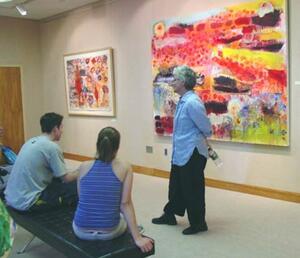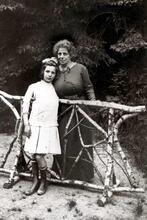Joan Snyder
While taking an introductory painting course, Joan Snyder had an epiphany and decided to enter the Master of Fine Arts program at Rutgers University in 1963. She moved to New York City in 1967 and soon began incorporating materials she associated with female imagery into her works. In 1969, Snyder painted Lines and Strokes, her breakthrough work, and her first solo exhibition of these paintings in 1971 was a sellout. She initiated the Women Artists Series program at Douglass College and was one of the founding members of the Heresies collective, a group of feminist artists, critics, and historians. Snyder’s works are strongly associated with the 1970s feminist movement and deal with topics such as nature and fertility, AIDS, the exploitation of women and children, and her own Jewish heritage and the Holocaust.
Overview
“Making art is, for me, practicing a religion. … My work is my pride, creates for me a heritage. It is a place to struggle freely at my altar.” These words were spoken by Joan Snyder for the Fortieth Biennial Exhibition of Contemporary American Painting held at the Corcoran Gallery in Washington, D.C. in 1987. Twenty-five years earlier Snyder experienced an epiphany, which she expressed with these words, “I felt like my whole life, I had never spoken … had never been heard … had never said anything that had any meaning. When I started painting, it was like I was speaking for the first time.” Joan Snyder is known for the intensity of her feelings. A true Expressionist and feminist in her life and art, this veteran painter uses the broadest possible palette to paint the canvas of her life.
Early Life and Breakthrough Work
Born on April 16, 1940, in Highland Park, New Jersey, Joan Snyder is a second-generation American artist of Russian-German Jewish descent who comes from a working-class family. Her father, Leon Snyder, a toy salesman, was born on February 24, 1901, and died on September 14, 1993. His family was originally from Germany and he was also a second-generation American. Her mother, Edythe Cohen Snyder, was born August 27, 1906, and died October 25, 1992. She was a bookkeeper whose parents came from Russia.
Snyder attended Hebrew School at a Reform temple in New Brunswick, New Jersey, and was confirmed at the age of thirteen. Her older brother, Stephen, was born on April 13, 1937, and her sister, Suellen, was born on November 25, 1944. Today Suellen Snyder is a social worker and therapist, and Steve Snyder is an aeronautical engineer and author.
Joan Snyder has a strong Jewish identity and holds large Passover Lit. "order." The regimen of rituals, songs and textual readings performed in a specific order on the first two nights (in Israel, on the first night) of Passover.seders in her home, but her parents were not religious and she is not observant. However, she was very close to her maternal grandmother Cohen, who was an Orthodox Jew, which made a lasting impact on Snyder. In 1964 Snyder painted Grandma Cohen’s Funeral Painting, dedicated to her grandmother.
From the first paintings Snyder made it was clear she was an American Expressionist painter with strong European roots. Snyder graduated from Douglass College in New Jersey with a B.A. in sociology in 1962. Four months into an introductory painting course she had the revelatory experience that changed her life and entered the Master of Fine Arts program at Rutgers University in 1963, graduating in 1966. Her earliest paintings show the related influences of German Expressionism, Alexei Jawlensky (1864–1941), Wassily Kandinsky (1866–1944), and her own background. Snyder says, “I believe my Russian and German heritage had a profound impact on my art. The German angst is a part of me.”
Snyder moved to New York City in 1967 and in the late 1960s began incorporating materials she associated with female imagery into her paintings, such as flocking (a thin, inexpensive type of cloth), beans, lentils, seeds, threads, and silk, making what she referred to as internal landscapes. These “flock/membrane” paintings, such as Flock Painting of Women (1969), were organic, anthropomorphic and body-like. Snyder completed these paintings before her marriage to the distinguished international photographer, Larry Fink (born March 11, 1941). They eloped and were married by a Justice of the Peace in Amenia, New York, on October 12, 1969. In August of that year, she painted Lines and Strokes, a breakthrough in her painting to that point. This began a series of brushed canvases which resembled paint strokes in a loose grid format. Snyder’s initial notoriety began with her first solo exhibition of these paintings in 1971 at Paley and Lowe in New York’s SoHo, which was a sellout. Snyder soon started receiving invitations to participate in women’s exhibitions. She initiated the Women Artists Series program at Douglass College and curated this series in its first crucial year of 1971. Snyder said, “These were the years right before the dawning of the women’s/feminist art movement.”
Feminist Art of the 1970s
In 1971 Snyder purchased a farm in Martins Creek, Pennsylvania, and moved there with her husband in 1973; here Larry Fink continued to reside and work. Around 1973–1974, she began to incorporate childlike drawings of landscapes, houses, stick figures, and parts of the female body into her paintings. Scrawled notes, torn valentines, diaristic scribbled words, fabric, papier-mâché, and wallpaper appear. While Snyder had won early recognition for her “stroke” paintings, participation in feminist consciousness-raising groups helped her realize her work had to become more specifically autobiographical: “I had nowhere to go but into my own past again, into my own iconography.”
Snyder’s work became more expressive, personal, and openly feminist. In paintings such as Flesh/Art (1973–1974), curved gashes have been cut into flesh-colored canvas and filled with rich, thick pigment. In Heart-On, (1975), collaged materials such as paper, cheesecloth, mattress batting, and thread form different shapes, including a heart-shaped Valentine box, shapes with sewn-up cuts and others which spill out of the grid system Snyder used extensively in the 1970s to give order to her work. She began treating her paintings as objects by stuffing, sewing, tearing, or slashing the canvas in her exploration of materials and female imagery. Like a diary entry, a private symbolism of written words and a predominance of wound-like female genitalia images emerge.
By 1975 Joan Snyder had become a powerful, eloquent voice for the struggles of the women’s art movement. She was one of the founding members of the Heresies collective, a group of feminist artists, critics and historians, who held their first meeting in November 1975 in the New York loft of artist Joyce Kozloff. Snyder would say later, “I believe that women artists pumped the blood back into the art movement in the 1970s and the 1980s. At the height of the Pop and Minimal movements, we were making...art that was personal, autobiographical, expressionistic, narrative and political.”
Later Work and Exhibitions
Snyder left her Pennsylvania farm in 1980 and returned to New York with her one-year-old daughter, Molly Snyder-Fink, born on June 4, 1979, a documentary filmmaker, painter, and writer. Joan also met her longtime Boston art representatives and friends Nina Nielsen and John Baker in 1980. Snyder’s unhappiness over her broken marriage found expression in her 1983 paintings Apple Tree Mass and Mourning/Oh Morning, a dark work that expresses her sorrow about an earlier miscarriage, the dissolution of her marriage and the pain of life. Snyder and her husband divorced in 1985.
During the early 1980s Snyder had been spending her summers in Eastport, Long Island, and she moved her studio and residence there in, 1985. With the full powers of a mature painter, she celebrated nature, fertility and renewal in Beanfield with Music for Molly (1984), I Felt Like a Virgin Again (1985), and Moonfield (1986). She says, “This work reflects all of my moods, my sorrows, losses and struggles, and a peace that has finally come into my life.”
In works of the late 1980s and 1990s, Snyder turned her attention to issues of fear and suffering. Disturbed by the cruelty and exploitation of women and children around the world, she said, “I started reading a series about the children of darkness. … I wanted to make some kind of political statement.” She painted Boy from Africa (1988), Morning Requiem (For the Children) (1987) and Journey of the Souls (1993), referring to the tragedy of AIDS. Paintings such as these take us to a new level of global concern for Joan Snyder. Her Morning Requiem with Lit. (Aramaic) "holy." Doxology, mostly in Aramaic, recited at the close of sections of the prayer service. The mourner's Kaddish is recited at prescribed times by one who has lost an immediate family member. The prayer traditionally requires the presence of ten adult males.Kaddish (1987–1988) and Women in Camps (1988) explicitly refer to her Jewish heritage, background, and haunting reverence for victims of war and the Holocaust, as does her exhibition Kaddish/Requiem, held at The Philadelphia Museum of Jewish Art in 2000–2001, which mourned the dead using Hebrew and Latin phrases.
Joan Snyder received the National Endowment for the Arts Fellowship in 1974 and the Guggenheim Memorial Fellowship Award in 1983. Her paintings are in the permanent collections of The Museum of Fine Arts, Boston; The National Museum of Women in the Arts, Washington, D.C.; The Whitney Museum, The Metropolitan Museum of Art, The Jewish Museum and The Museum of Modern Art in New York.
Joan Snyder divides her time between Brooklyn, New York, and Woodstock, New York. She shares her life with Maggie Cammer, her longtime partner, a semi-retired New York State Acting Supreme Court Justice.
Books
Chadwick, Whitney. Women, Art, and Society. New York: 1990.
Broude, Norma, Mary D. Garrard, and Judith K. Brodsky. The Power of Feminist Art: The American Movement of the 1970s, History and Impact. New York: 1994.
Hammond, Harmony. “Joan Snyder.” In Lesbian Art in America: A Contemporary. New York: 2002.
Interviews
Smith, Beryl, Joan Arbeiter, and Sally Shearer Swenson. Lives and Works: Talks with Women Artists, vol. 2. Lanham, MD, and London: 1996.
Sally Swenson interviews Joan Snyder in 1992.
Iskin, Ruth E. “Toward a Feminist Imperative: The Art of Joan Snyder.” Chrysalis 1 (1977): 101–115.
Exhibition Catalogs
Joan Snyder: The Nature of Things. Boston: 2002.
Joan Snyder: Primary Fields. New York: 2001.
Joan Snyder Paintings and Sketches. New York: 1998.
Joan Snyder, Painter: 1969 to Now. Boston: 1994.
Joan Snyder Collects Joan Snyder. Santa Barbara: 1988.
Articles and Reviews
Diehl, Carol. “Nests, Wounds and Blossoms.” Art in America, February 2002.
Gill, Susan. “Painting from the Heart.” Artnews 86/4 (April 1987): 128–135.
Jones, Bill. “Painting the Haunted Pool.” Art in America 82/10 (October 1994).
Webster, Sally. “Joan Snyder, Fury and Fugue: Politics of the Inside.” Feminist Art Journal 5/2 (Summer 1976).
Shirey, David L. “Spirited Feminist Wields Bold Brush.” The New York Times, February 12, 1978.
Smith, Roberta. “Artworks That Strike Up Conversations With Viewers.” The New York Times, April 1, 1988.
Essay
Perl, Jed. “Abstract Matters.” In Eyewitness: Reports from an Art World in Crisis. New York: 2000.





